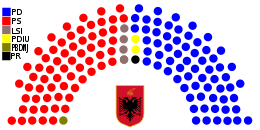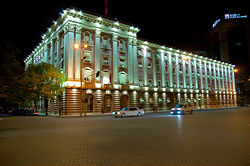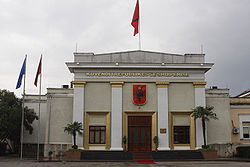- Assembly of the Republic of Albania
-
Parliament of Albania
Kuvendi i ShqipërisëLegislature XVIII 
Type Type Unicameral Leadership Chairperson PD, PD
since 3 September 2005Parliamentary Leaders Astrit Patozi (PD)
Gramoz Ruçi (PS)
Ilir Meta (LSI)
Shpëtim Idrizi (PDIU)
Fatmir Mediu (PR)
Vangjel Dule (PBDNJ)Structure Members 140 (list) 
Political groups Alliance for Change (70)
Unification for Change (66)
Socialist Alliance (4)Elections Voting system Closed list proportional representation Last election 28 June 2009 Meeting place 
Parliament's Building
Rruga e Elbasanit
Tirana
Republic of Albania.
The meeting hall prior to the August 2010 reconstruction.Website www.parlament.al Footnotes For current list of members see list of members. The Parliament of Albania (Albanian: Kuvendi i Shqipërisë or short Kuvendi or Parlamenti), formerly the People's Parliament (Albanian: Kuvendi Popullor) is the unicameral parliament of the Republic of Albania. It has 140 members, elected for four-year terms. The electoral system is closed list proportional representation. There are 12 multi-member constituencies, corresponding to the country's 12 administrative regions. Within any constituency, parties must meet a threshold of three percent of votes; pre-election coalitions must meet a threshold of five percent. All laws passed by the parliament are published by the Albanian Official Journal (Albanian: Fletorja Zyrtare), the official journal of the government of Albania.[1]
The President is elected by the parliament. The current members were chosen in 2009.
List of Chairmen of the Parliament of Albania
Main article: Chairman of the Parliament of AlbaniaParliamentary lists and parties
Summary of the 28 June 2009 Assembly of Albania election results Coalitions Votes % Seats Total "Alliance for Changes" (Center - Right) 712745 46.92 70 Total "Unification for Changes" (Center - Left) 688748 45.34 66 Total "Socialist Alliance" (Progressive Left) 84407 5.56 4 Total "Pole of Freedom" (Conservatism) 27655 1.82 0 Law and Justice Party of Albania (Partia Ligj dhe Drejtësi) PLiDr 4865 0.32 0 Independent (Abdullah Adil Omurri) PAVARUR 756 0.05 0 Total (turnout: %) 1519176 100.00 140 Source: CEC Renovation
Since the end of the 2010 parliamentary season, the parliament has been renovated.[citation needed]
Committees
The Albanian parliament has the following 10 committees:[2]
- Ad-Hoc Conmmitties
- Committee on Legal Affairs, Public Administration and Human Rights
- Committee for European Integration
- Committee on Foreign Policy
- Committee on Economic and Finance
- Committee on National Security
- Committee on Productive Activities, Trade and Environment
- Committee on Labour, Social Affairs and Health
- Committee on Education and Public Information Media
- Special Committee
Background
The legislative system in Albania has a relatively short history, and is closely related to the history of the state. During this period, it has evolved under different regimes.
History
National Assembly of Vlora (1912)
The parliamentary institutions in Albania have their beginnings in the late-1912 Albanian Independence from the Ottoman Empire. The National Assembly of Vlora served as the Albanian legislative body for two years, until the 1914 statute.
Albanian state under Prince William of Weid and 1914 Organic Statute
The National Assembly of Vlora continued its work as the national legislative body for several years. This assembly provided the first organic Statute of Albania, prepared by the International Commission of Control in 1914. Under the statute, the National Assembly was a legislative body composed of members elected by the people, appointed by the prince and members "ex officio" (a total of 36). After serving for eight years, the National Assembly of Vlora ended its mission after losing the border war against neighboring countries which was resolved in the Treaty of London.
1920 creation of the Senate
The Lushnja Congress created the Senate (the first Albanian Parliament, later the National Council) as the legislative body, which consisted of 37 members elected by delegates to the Congress. The Congress expressed, in the form of organized political will of shqiptarëvge, to take the country's destiny into its own hands. During this period, for the first time was affirmed the principles of parliamentarianism: the appointment and dismissal of the government by the Senate, and the exercise of parliamentary control. Although the first Albanian parliament carried out its legislative activities over a short period of time, it passed several important laws. The most important act was the Statute of Lushnja, which established constitutional law. The legislative activity of the National Council ended in December 1920, when the Council was dissolved to prepare the country for its first election in March 1921.
1922 Statute of Lushnja extension
By-elections were held in March 1921, and the country was represented by 78 deputies. At this time Parliament began to meet regularly as a body, with clearly defined tasks and a timetable. In 1922 the Statute of Lushnja was expanded into a constitution with the highest power given to the state and a legitimate parliament. The former National Council was renamed the Parliament. The legislative body consisted of a chamber of deputies, indirectly elected by the people. During this period, two political groups emerged: the People's Party (led by Fan Noli) and the Progressive Party (led by Hoxha Kadriu). In the legislative field, the activity of the National Council focused on such matters drafting the law on judicial organization, amending existing regulation with new elements for the transparency of parliamentary activity and crafting the oath of deputies to the Council. In September 1923 the National Council closed its proceedings at the conclusion of the legislature to prepare the country for new elections to the Constitutional Assembly, held in December of that year.
1924–1925 Constitutional Assembly
The Constitutional Assembly, consisting of 100 deputies, convened over two periods (21 January–2 June 1924 and December 1924–March 2, 1925). Its main task was the drafting of a written constitution. That objective was not achieved during the first period of activity due to the assassination attempt on Prime Minister Ahmet Zog by Avni Rustemi. On 2 June 1924 the Assembly closed the first session of proceedings. After the dissolution of the government Zog left Albania, remaining underground until December 1924. During this period, the short-lived (June–December 1924) government of Fan Noli gained power. With the return to power of Ahmet Zog (marking the resumption of the rule of law), the Constitutional Assembly resumed work. It finally accomplished the task for which it was created: adoption of the basic statutes of the state, which would determine its future.
1925–1928 Republic of Albania
Albania's form of government was defined as a parliamentary republic, headed by a president whose sovereignty was derived from the people. By decree of the Constitutional Assembly, Ahmet Zog was elected head of state. For the only time in Albania's history, its parliament consisted of two chambers: the Senate and the Chamber of Deputies. The Chamber of Deputies (the lower house) consisted of 57 deputies elected by the people, and the Senate (the upper house) consisted of 18 senators (two-thirds of whom were elected by the people and one-third chosen by the President of the Republic). This bicameral system gave priority in certain cases to the Senate, putting the Chamber of Deputies in a position of inferiority. When Parliament's two chambers met in joint session, it was known as the Legislative Assembly and separately noted as such in statutes. During this time Parliament adopted a series of important laws, including national-bank and civil-pension laws. There was a lack of pluralism, due to the lack of representation in the electoral system. A lack of political parties characterized the rule of Ahmet Zog as President of the Republic, and then as King of the Albanians. A redistribution of Parliament came after a debate to change the form of government, preparing the country for new elections to the Constituent Assembly.
Albanian kingdom (1928–1939)
The Constitutional Assembly emerged from the elections of 17 August 1928 with 58 members, a statute-sanctioned monarchical form of government and a unicameral parliamentary system. Albania proclaimed itself a "democratic, parliamentary, and hereditary kingdom" headed by "His Majesty Zog I". Before its conclusion on December 1, 1928, the Constitutional Assembly adopted a civil, commercial and penal code and a code of civil procedures, which marked the drastic break from the legislation of the Ottoman period. For this reason, this parliament was called by Zog I the "constructive" and "reformist parliament."
After the Italian invasion of Albania in April 1937, King Zog I fled the country. The King of Italy, Victor Emmanuel III, was offered the crown of Albania.
Parliament during the war
Under the statute of the Albanian kingdom charter awarded by King Victor Emmanuel III, the Albanian state was a constitutional monarchy. Legislative power was exercised by the king, in cooperation with the Fascist Party. On October 16, 1943 (during the Nazi invasion) the National Assembly convened with 247 members, who restored the creation of the High Council as head of state. It returned to parliament, exercising legislative power with this body. This period is characterized by the denial of the principles of parliamentarianism.
Postwar parliament
Elections for the Constituent Assembly after the war were held on December 2, 1945. For the first time, women were allowed to vote. The constitution was adopted on 14 March 1946, when the Constitutional Assembly became the National Assembly. In the absence of domestic political pluralism, the National Assembly met only twice a year. In 1976 Parliament adopted the Constitution of the People's Socialist Republic of Albania, which preserved features of an ideological political program in accord with the ideology of the time. Parliament's role remained weak, since free elections were not held.
1991 rebirth of parliamentarianism
After more than five decades, the first signs of revival of parliamentarianism appeared in Albania. After 67 years, the first pluralistic parliament emerged from the elections of 31 March 1991 with 250 members. Constitutional provisions adopted that year brought changes in the framework of the democratic organization of the state. It was gradually supplemented by a number of other constitutional laws and by the adoption of a comprehensive new constitution. On October 21, 1998 Parliament adopted a new constitution, drafted with the help of international organizations. The new constitution created the opportunity to better understand the political system in Albania and the role of its participants. The People's Assembly of Albania was unicameral, with 140 members. After the implementation of the Constitution Parliament, as the highest legislative power, was responsible for drafting and approving laws. The role of the Assembly has increased significantly in creating a constitutional and legal framework as the premise for the rule of law, and it has become the most important institution of political development in the country. Legislative activity has become one of the most active instruments in the consolidation of state institutions and Euro-Atlantic integration.
See also
- List of members of the Assembly of the Republic of Albania (2009-present)
External links
References
Parliament of Europe Sovereign
states- Albania
- Andorra
- Armenia
- Austria
- Azerbaijan
- Belarus
- Belgium
- Bosnia and Herzegovina
- Bulgaria
- Croatia
- Cyprus
- Czech Republic
- Denmark
- Estonia
- Finland
- France
- Georgia
- Germany
- Greece
- Hungary
- Iceland
- Ireland
- Italy
- Kazakhstan
- Latvia
- Liechtenstein
- Lithuania
- Luxembourg
- Macedonia
- Malta
- Moldova
- Monaco
- Montenegro
- Netherlands
- Norway
- Poland
- Portugal
- Romania
- Russia
- San Marino
- Serbia
- Slovakia
- Slovenia
- Spain
- Sweden
- Switzerland
- Turkey
- Ukraine
- United Kingdom
- (England
- Northern Ireland
- Scotland
- Wales)
States with limited
recognition- Abkhazia
- Kosovo
- Nagorno-Karabakh
- Northern Cyprus
- South Ossetia
- Transnistria
Dependencies
and other territories- Åland
- Faroe Islands
- Gibraltar
- Guernsey
- Jan Mayen
- Jersey
- Isle of Man
- Svalbard
Other entities - European Union
 Albania topics
Albania topics- Index
- Outline
Symbols People History - Origins
- Praevalitana
- Epirus Nova
- Middle Ages
- Albania under the Bulgarian Empire
- Albania under the Serbian Empire
- Principality of Arbër
- Kingdom of Albania
- Albanian Principalities in Middle Ages
- League of Lezhë
- Venetian Albania
- Ottoman Albania
- Albanian Pashaliks
- Massacre of the Albanian Beys
- Albanian National Awakening
- Revolts of 1833–1839
- Revolt of 1843–1844
- Revolt of 1847
- League of Prizren
- League of Peja
- Revolt of 1910
- Battle of Deçiq
- Independence Declaration
- Provisional Government of Albania
- Albania during the Balkan Wars
- Principality of Albania (1914–1925)
- Italian Protectorate on southern Albania
- Vlora War
- Republic of Mirdita
- Albanian Republic (1925–1928)
- Albanian Kingdom (1928–1939)
- Albania under Italy (Invasion
- Colonization)
- Albania under Germany
- Resistance
- Communist Albania (1946–1992)
- Post-Communist Albania (since 1992)
- Timeline to 1993, 1994–Present
Politics - Constitution
- Heads of State
- Prime Minister
- Parliament
- Political parties
- Elections (2007)
- Counties
- Districts
- Municipalities
- Foreign relations
- History of Kosovo
- Kosovo War
- LGBT rights
Geography - Cities:
- Geographical Regions:
- Northern Mountain Range
- Southern Mountain Range
- Western Lowlands
- Central Mountain Range
- Mountains:
- Seas:
- Rivers:
- Drin River
- Buna River
- Vjosë
- Black Drin
- Lakes:
- Lake Skadar
- Lake Ohrid
- Lake Prespa
- Lagoons:
- Karavasta
- Narta
- Plains:
- Myzeqe
- Korçë Plain
- Zadrima
- Capes:
- Cape of Gjuhëz
- Cape of Rodon
- National Parks:
- Butrint
- Lura
- Llogara
- Thethi
- Valbona Valley
- Shebenik-Jabllanica
- Fir of Hotova
- Karaburun-Sazan
Economy Military - Military
- Air Force
- Rapid Reaction Brigade
- Naval Defense Forces
- Joint Forces Command
- Support Command
Culture - Languages
- Costume
- Nationalism
- Literature
- Cinema
- Cuisine
- Emigration
- Music
- Sports
- Holidays
- Religion
- Television
- Radio
- Mythology
- Epic Poetry
Religion - Islam
- Albanian Orthodox Church
- Roman Catholicism
- Protestanism
- Byzantine Catholicism
Categories Tirana Neighbourhoods Divisions Tirana 1 · Tirana 2 · Tirana 3 · Tirana 4 · Tirana 5 · Tirana 6 · Tirana 7 · Tirana 8 · Tirana 9 · Tirana 10 · Tirana 11Streets, squares and bridges Skanderbeg Square · Ali Demi Street · Bajram Curri Boulevard · Elbasan Street · Kavajë Street · Dibër Street · Durrës Street · Zogu I Boulevard · Dëshmorët e Kombit Boulevard · Zhan D'Ark Boulevard · Mustafa Lleshi Street · Pjetër Budi StreetMajor landmarks Parks: Tirana Park on the Artificial Lake · Rinia Park · Botanical Gardens of Tirana
Palaces: Presidential Palace of Tirana · Palace of Culture of Tirana · Fortress of Justinian · Palace of Congres
Monuments and remembrance: Skanderbeg Monument · Enver Hoxha Mausoleum · Suleyman Pasha Tomb · Kapllan Pasha Tomb · Bride's Tomb · Unknown Soldier · Mother Albania (statue) · National Martyrs Cemetery of Albania · Clock Tower of Tirana · Tanners' Bridge · Tirana Mosaic
Other: Tirana ZooMuseums, archives and libraries National Historical Museum · National Gallery of Figurative Arts of Albania · Natural Sciences Museum of Albania · National Archaeological Museum · Ethnographic Museum · National Archives of Albania · National Library of Albania · Assembly of the Republic of AlbaniaReligion Roman Catholic Archdiocese of Tiranë-Durrës · Archbishop of Tirana · Et'hem Bey Mosque · St Paul's Cathedral · Zemra e Krishtit Catholic Church · Resurrection of Christ Orthodox Cathedral of Tirana · Saint Procopius Church of Tirana · Sheh Dyrri TeqeEconomy and business TID Tower · Tirana Stock Exchange · Tirana Bank · ABA Business Center · QTU Shopping Centre · Tirana International Hotel · Sheraton Tirana Hotel and Towers · Rogner Hotel · Hotel Dajti · Taivani · Citypark AlbaniaEducation Academy of Music and Arts of Albania · Academy of Sciences of Albania · European University of Tirana · Luarasi University · Polytechnic University of Tirana · Academy of Physical and Sports Education Vojo Kushi · Tirana International School · University of Tirana · Agricultural University of Tirana · University of New York Tirana · Kristal University · Marin Barleti University · Marubi film school · Skanderbeg Military University · Ismail Qemali High School · Polytechnical High School · Qemal Stafa High School · Petro Nini Luarasi High School · Sami Frashëri High School · Çajupi High School · Artistic Lycee · Sports mastery school Loro BoriçiSport KF Tirana · Partizani Tirana · Dinamo Tirana · Qemal Stafa Stadium · Selman Stërmasi Stadium · Asllan Rusi Palace of SportsTransport Healthcare Mother Theresa Hospital · Tirana Military Hospital · Universal Hospital Tirana · Milingona HospitalMedia Arts and culture Festivali i Këngës në RTSH · Tirana Jazz Festival · Tirana Circus · National Theatre of Opera and Ballet of Albania · National Theater of Albania · Estrada Theatre of TiranaDialect Tirana dialectCoordinates: 41°19′34″N 19°49′23″E / 41.32611°N 19.82306°E
Categories:- Government of Albania
- Parliaments by country
Wikimedia Foundation. 2010.


